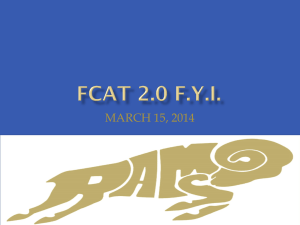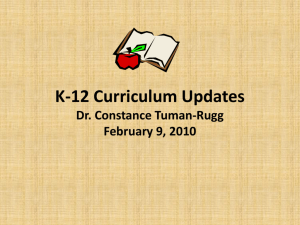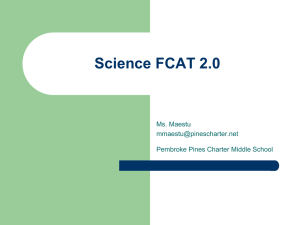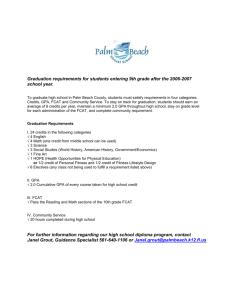PowerPoint Presentation - Assessment, Research, and Data Analysis
advertisement
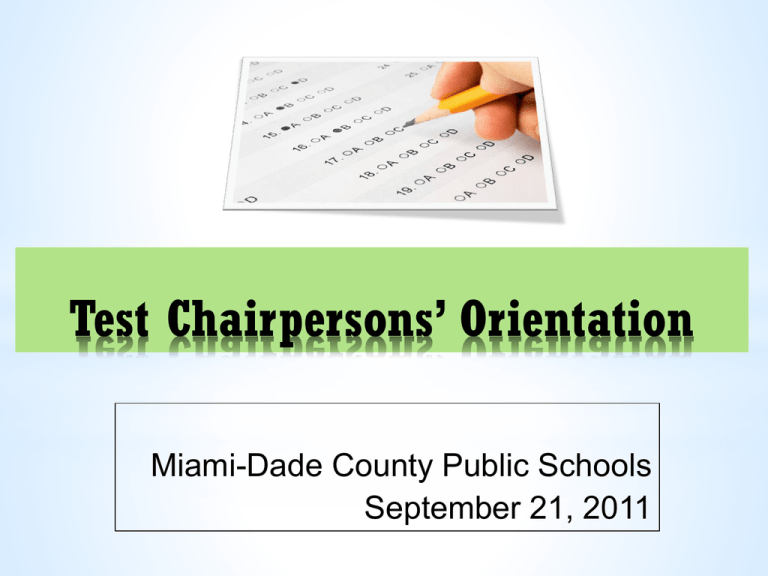
Test Chairpersons’ Orientation Miami-Dade County Public Schools September 21, 2011 * General Session Accountability – Gisela Field, Vilma Rubiera Assessment, Research and Data Analysis Instructional Validity Study – Sally Shay, Student Assessment 2011-12 Testing Program – Student Assessment Staff Caveon Data Forensics – Sally Shay, Student Assessment FDM Test Chair Function – Kathy Sierra, Hialeah Gardens Tiffany Davis, American Beatriz Ambas, Miami Lakes 2 * Afternoon Sessions Test Chair 101 – Zulema Lamazares, Greenglade Elementary Preparing for CBT – Maria Bruguera, Mara Ugando Student Assessment On-line CELLA – Deland Innocent, Caridad Perez Bilingual/World Languages 3 * Gisela Field Vilma Rubiera 4 * Sally Shay 5 * •OPPORTUNITY TO LEARN •First instructional validity study in Florida •High School Competency Test •1982 Debra P. vs. Turlington •Again for FCAT •Sunshine State Standards •Now FCAT 2.0 and EOC •Next Generation Sunshine State Standards 6 * •Public Awareness •Educator and Student Understanding •Curricular Validity •Instructional Validity •Student Remediation 7 * •District Level •School Level •Parent/Communty Meeting Notifications •Letters/Memoranda to Parents, Staff, Students •ConnectEd Messages •Website Postings •Professional Development Activities •Tutoring/Remediation Activities •Sample (Voluntary) Lesson Plans, Activities, Tests, Data Binders •Interim Assessment Debriefings 8 2011-12 Testing Calendar http://oada.dadeschools.net/TestingCalendar/TestingCalendar.asp 9 Program Updates: 10 FLORIDA COMPREHENSIVE ASSESSMENT TEST (FCAT) / FCAT 2.0 AND END-OF-COURSE (EOC) ASSESSMENTS Next Generation Sunshine State Standards (NGSSS) Maria C. Bruguera, Director I Mara Ugando, Staff Specialist 11 Transition to FCAT 2.0 and EOC Assessments Phasing-in FCAT 2.0 Science in grades 5 and 8 only Biology 1 EOC assessment will replace FCAT Science in high school Phasing-in Florida End-of-Course (EOC) Assessments (Algebra 1, Biology 1, and Geometry) United States History EOC will be field tested in selected senior high schools only Summer EOC Administration in 2012 Beginning 2012-13 three EOC administrations FCAT Writing scoring standards will be increased in 2012 12 will be offered Transition Schedule 13 Computer-based Testing (CBT) in 2011-12 The following FCAT / FCAT 2.0 assessments will be offered in CBT format: FCAT Reading Retake (optional): untimed FCAT Mathematics Retake: untimed FCAT Reading 2.0 Retake: two ½ day sessions over two days FCAT Reading 2.0 (Grades 6 and 10): two 70-minute sessions over two days Note: Paper-based accommodations for eligible students are available. 14 Computer-based Testing (CBT) in 2011-12, cont. The following EOC assessments will be offered in CBT format: Algebra 1: one 160-minute session* Biology 1: one 160-minute session* Geometry: one 160-minute session* US History Field Test: TBD Students may have additional time, if needed. Note: Paper-based accommodations for eligible students are available. 15 Updates: 2011-12 School Year High Schools Grade 9 students will be administered: o FCAT 2.0 Reading Grade 10 students will be administered: o FCAT 2.0 Reading graduation test on the computer • New passing score (minimum scale score in Achievement Level 3) No comprehensive FCAT Mathematics or Science assessment will be administered in high schools 16 Updates: 2011-12 School Year, cont. EOC Assessments will be on the computer Algebra 1 EOC will be administered to students (in any grade) enrolled in Algebra 1 or equivalent courses in December 2011 and/or May 2012, as applicable. o Students in middle schools and entering grade 9 students in 2011-12 must pass the Algebra 1 EOC assessment to earn high school credit. o Grade 10 students (entered grade 9 in 2010-11) will have 30% of the Algebra 1 EOC score calculated into the final grade 17 Updates: 2011-12 School Year, cont. EOC Assessments will be on the computer Biology 1 and Geometry EOC will be administered to students (in any grade) enrolled in Biology 1 and/or Geometry or equivalent courses in May 2012. o Students entering grade 9 in 2011-12 will have 30% of the Biology 1 and/or Geometry EOC scores calculated into their final grade o Any other grade level must participate in the Biology 1 and/or Geometry EOC but will not be impacted by test results 18 Certification Tool The Certification Tool is to be completed by each school that will offer computer-based assessment(s)in the 2011-12 school year. Six sections to complete: I. Computer Specifications II. Student Scheduling Plan III. Annual Checklist IV. Administration – Specific Checklist V. School Computer-Based Assessment Team VI. Submit to District Office 19 Certification Tool, cont. The tool must be completed for each test administration: Fall 2011 FCAT / FCAT 2.0 Retake December Algebra 1 EOC Spring 2012 FCAT / FCAT 2.0 Spring 2012 Algebra 1, Geometry, and Biology 1 EOC Semester 2 and US History EOC Field Test A two-week window will provided for schools to complete the tool for each test administration. Notifications to schools will be sent via Weekly Briefings. 20 TestHear New platform used to deliver accommodated forms (e.g., large print, zoom, color contrast, screen reader, assistive devices) for Florida’s high-stakes computer-based statewide assessments. Must be installed on all computers that will be used by eligible students requiring accommodated CBT forms (e.g., large print, zoom, screen reader, color contrast, assistive devices). Local installation is required. Note: Audio card and headphones are required for the computers that will run the Screen Reader accommodation. 21 Infrastructure Trial The Infrastructure Trial simulates a computer-based test using mock test items that will allow schools to test hardware and network capacity prior to the CBT operational administration. It should take approximately thirty minutes for users to log in, supply random answers, and submit the test. o Please note that the content of the test used for the Infrastructure Trial is NOT intended for student practice. Schools must set up the Trial to use all computers scheduled to be used concurrently during the spring 2012 CBT administrations. Test Hear accommodated form will be added this week to Infrastructure Trial. These forms are larger (50 MB) than regular TestNav forms (2 MB). 22 Practice Test (ePat) All students MUST participate in a practice test at the school prior to taking a CBT assessment. A practice session is required for each CBT assessment (i.e., FCAT Retake, Algebra I EOC). Practice test script must be used when conducting the practice session . The script describes the presentation of items and computer tools available to introduce students to the computer-based system. Students are required to participate in a practice test using the ePAT with the same accommodations that will be provided to them on the operational assessment. 23 Interim Assessment Program Formative Classroom Assessment Felicia Mallory, Executive Director Denetra Collins, Staff Specialist 24 Purpose of the Baseline Benchmark Assessments (BBA) To determine students’ baseline knowledge of the Next Generation Sunshine State Standards in Reading, Mathematics, and Science. To provide teachers with a quick snapshot of students’ initial knowledge and abilities to focus instruction. To provide for state required progress reports in schools classified under the Differentiated Accountability System as Prevent I or II, Correct I or II, or Intervene. Program guide and instructions for downloading the assessments are available on our website at http://oada.dadeschools.net/IAP/IAP.asp 25 Purpose of Interim Assessment Tests To monitor student progress on the Reading, Mathematics, and Science Next Generation Sunshine State Standards (Fall and Winter) To provide teachers with classroom assessment tools that will provide reliable student-level benchmark information to inform instruction To provide students with information on their progress on specific benchmarks To provide Differentiated Accountability schools with a reliable and valid assessment tool for state progress reporting. 26 Overview of the Interim Assessment Program Interim Assessment tests administered three times per year: (BBA, fall, and winter) Alignment with the Next Generation Sunshine State Standards and District’s pacing guides Benchmark Assessment Item Banks for Reading and Mathematics are available in ExamView Data analysis and disaggregation, score reports, and item analysis are available in Edusoft 27 Interim Assessment Administration Windows 2011-2012 Administration Windows BBA - August 22, 2011 – September 2, 2011 Fall - October 17 – October 31, 2011 Winter - January 9 – January 20, 2012 - Subjects and Grade Levels Reading : Grades 3-10, Retake NGSSS, Retake SSS Mathematics: Grades 3-8; Algebra 1 , Geometry, Retake SSS Science: Grades 5, , 8, and Biology 1 Reading : Grades 3-10, Retake NGSSS, Retake SSS Mathematics: Grades 3-8; Algebra 1, Geometry, Retake SSS Science: Grades 5, , 8, and Biology 1 Reading : Grades 3-10, Retake NGSSS, Retake SSS Mathematics: Grades 3-8; Algebra 1, Geometry, Retake SSS Science: Grades 5, , 8, and Biology 1 *All Differentiated Accountability Intervene and Correct II D or F Schools must complete testing during the first scheduled week. 28 Note. Fall and Winter Grades 6 and 10 Reading and Algebra 1 will be administered on computer . Approximate Testing Times Before the Test Approximately 10 minutes to pass out testing materials Administration Time Reading*: Approximately 70 minutes After the Test Approximately 10 minutes to collect testing materials Mathematics*: Approximately 75 minutes Science*: Approximately 112 minutes * It is suggested that assessments be administered over a two-day time period. 29 Students to Be Tested All eligible students* must take the Interim Assessment in Reading, Mathematics, and Science. Reading, Grades 3-10,* Mathematics, Grades 3-8* Science: Grades 5 and 8* All students enrolled in: Algebra I** Geometry** Biology I** *Students MUST take the test corresponding to the grade level in which they are listed in ISIS. **Or an equivalent course 30 Grade Levels and Standards by Content Area IA Test Form Participating Students Standards Addressed NGSSS FCAT/EOC Form Reading, Grades 3-10 Grades 3-10 Reading, Grade 10 First Time Retakers NGSSS FCAT 2.0 Reading Retake SSS All Other Retakers SSS FCAT Mathematics, Grades 3-8 Grades 3-8 NGSSS FCAT 2.0 SSS FCAT Mathematics Retake (SSS) Retakers FCAT 2.0 Science Grades 5 and 8 NGSSS FCAT 2.0 Algebra I Enrolled students NGSSS Algebra I EOC Geometry Enrolled students NGSSS Geometry EOC Biology I Enrolled students NGSSS FCAT 2.0 31 Interim Assessment Computer-Based Testing The following Interim Assessments (IAs) will be computer-based for the Fall and Winter administrations: Grade 6 Reading Grade 10 Reading Grade 10 Reading Retake NGSSS Algebra 1 32 Interpreting Performance Levels for the NGSSS, 2011-12 The Next Generation Sunshine State Standards test forms will utilize the Edusoft default of 70% for Overall and Question Group Bands. • Proficient set at 70% • Non Proficient set at 69% and below Performance levels for Fall and Winter forms will be made available in 2011-12 after the new FCAT 2.0 Scaled Scores and corresponding Achievement Levels have been set by the FLDOE. IA Science and Geometry performance levels will not be available until the 2012-13 school year. 33 Performance Levels for Retake (SSS) Forms The Performance Levels for grade 10 Reading and Mathematics tests based on the original Sunshine State Standards are as outlined. Satisfactory Progress Students who are likely to score in FCAT levels 3 and above Limited Progress Students whose performance was not sufficient to predict success. Insufficient Progress Students who are likely to score below FCAT level 3. This student demonstrated a satisfactory level of achievement on the content focus of the Florida Sunshine State Standards assessed during this instructional period. To attain high levels of achievement in this content area, the student must receive continued instruction on the challenging content and skills across the benchmarks designated for this grade level. This student demonstrated a limited level of achievement on the content focus of the Florida Sunshine State Standards assessed during this instructional period. To attain high levels of achievement in this content area, the student must receive targeted interventions and remediation in the areas of concern, and continued instruction on the challenging content and skills across the benchmarks designated for this grade level. This student demonstrated an insufficient level of achievement on the content focus of the Florida Sunshine State Standards assessed during this instructional period. To attain high levels of achievement in this content area, the student must receive intensive interventions and remediation in the areas of concern, and continued instruction on the challenging content and skills across the benchmarks designated for this grade level. 34 Reading Forms – Grade 10 BASELINE ASSESSMENT TEST FORM Grade 10 Reading (NGSSS Standards) ADMINSTERING STUDENTS EDUSOFT EDUSOFT FOLDER ANSWER SHEET TITLE First time 10th Grade Reading Grade 2011 Computerstudents 10 (NGSSS) Based Interim Assessments Reading Grade 2011 ComputerFirst time Retakers 10 Retake Based Interim (mostly 11th Grade students: (NGSSS) Assessments those who failed to pass the FCAT Reading 2.0 in March 2011 when they were in grade 10) Reading Retake (SSS) All other Retakers Reading Retake (mostly 12th Grade students, (SSS) or 11th Grade students who took the retake last year) 35 2011 Interim AssessmentsRetake folder Score Reports Useful reports that can be retrieved via Edusoft: Class List Reports Item Analysis Report Item Response Report Student Performance Report Subgroup Report Custom Group Report Performance Band Report 36 Benchmark Assessment Item Bank To allow teachers to monitor student progress on the Reading and Mathematics Next Generation Sunshine State Standards To provide teachers with classroom assessment tools that will provide reliable student-level benchmark information to inform instruction To provide students with information on their progress on specific benchmarks Item Bank Resources: Item Bank Overview Item Bank Newsletter Download Examview Test Generator 37 Comprehensive English Language Learners (CELLA) Felicia Mallory, Executive Director Denetra Collins, Staff Specialist 38 Overview of CELLA CELLA is a four-skill English language assessment measuring student proficiency in listening, speaking, reading, and writing. Students in grades 1 – 12 are administered the Listening, Reading, and Writing sections in groups Speaking on a one-on-one basis Kindergarten students are assessed in all four areas on a one-to-one basis. Unlike the FCAT, CELLA is not a timed test. 39 Purposes of CELLA The test results can provide: Data useful for charting student progress over time, Diagnostically useful information about students’ strengths and weaknesses in English, The language proficiency levels of individual students can be used in making decisions regarding placement into, or exit from English for Speakers of Other Languages (ESOL) programs. Identifying the proper ESOL level, Determining whether the District and schools met Annual Measureable Achievement Objectives (AMAOs) 40 Annual Measurable Achievement Objectives (AMAOs) AMAO 1: Progressing in English language acquisition annual increases in the number or percentage of students making progress in learning English AMAO 2: Exiting or reaching English language proficiency annual increases in the number or percentage of students attaining English language proficiency by the end of each school year AMAO 3: ELL-Adequate Yearly Progress (AYP) AYP for the ELL subgroup in demonstrating proficiency on grade-level in reading and mathematics on the FCAT 41 Important Dates for 2012 CELLA Administration: Individual : March 5 – April 6, 2012 Group : March 5 – March 31, 2012 42 National Assessment of Educational Progress (NAEP) Felicia Mallory, Executive Director Denetra Collins, Staff Specialist 43 Features of NAEP-TUDA Provides district-level data to participating urban districts Provide a common yardstick to measure student achievement in comparison to Other urban districts States Large Central Cities National Public Schools Census Regions 44 Purpose of the National Assessment of Educational Progress (NAEP)/TUDA A common nationwide measure of student performance Reports changes over time. Provides results for the nation, states, and some urban districts. Secondary indicator for state progress and allows national comparisons between states and large urban districts Used by the President, Congress, and state leaders to set education policy 45 Overview of the NAEP A representative sample of schools and students are selected Randomly selected students in grades 4, 8, and 12 are assessed in reading, writing, mathematics, economics, and writing. Assessments includes multiple-choice and constructed responses. Assessments are administered by NAEP field staff Assessments are 90 to 120 minutes, which include testing and answering background questions Accommodations are offered for ELL and SWD students. Results are reported by scale scores, subscales, achievement levels, subgroups, and geography 46 2012 Assessments Operational Components Grades/ Ages Pilots Grades /Ages Long-Term Trend in Reading 9, 13, 17 Reading LTT 9, 13, 17 Mathematics LTT 9, 13, 17 Long-Term Trend in Mathematics 9, 13, 17 Writing—ComputerBased 4 Reading 12 Economics 12 Mathematics 12 47 NAEP 2012 Assessment Dates Type of Assessment Assessment Dates Age 13 October 10 - December 16, 2011 Age 9 January 9 – March 16, 2012 Age 17 March 19 – May 25, 2012 Grade 12 Economics, Reading, Math January 23 – March 2, 2012 Grade 4 Writing Pilot January 23 – March 2, 2012 LTT 48 Important Dates for NAEP 2012 Event Date Provide School Information Form registration September 30, 2011 (Age 13 LTT) NAEP field staff will contact schools to schedule an assessment visit September (Age 13 LTT) Pre-Assessment packet arrives in selected schools September (Age 13 LTT) Pre-Assessment visits September (Age 13 LTT) NAEP Testing Administration Window Age 13 – October 10 – December 16, 2011 Age 9 – January 9 – March 16, 2012 Age 17 – March 19 – March 25, 2012 Grades 4 and 12 – January 23 – March 2, 2012 49 NAEP-TUDA 2011 Release Date Subject and Grade Release Date Math – Grade 4 and 8 Reading – Grades 4 and 8 November 2011 50 Florida Competency on Personal Fitness (FCEPF) 51 Denetra Collins, Staff Specialist Stanford Achievement Test, Tenth Edition (SAT-10) • Mayda Cabeza, Director I 52 SAT-10 What is the SAT-10? Who is administered the SAT-10? o Grades 1 and 2, districtwide o New for 2011 all kindergarten Important dates to remember o April 10-13, 2012 53 SAT-10 How do SAT-10 materials arrive to schools? Is the SAT-10 a secure test? SAT-10 Test Chairperson Training o (February 2011) School level training of test administrators and proctors Test Administration o Untimed 54 SAT-10 Results School Listing of Results (June) o Must be picked up at ITS Individual Student Reports (August) o Delivered to schools Results o Not available on the Parent Portal o Posted to SPI under the tab FCAT Scores Uses o Referral of students to the district’s gifted program (Plan A or Plan B) o Early identification of students who would be considered at high risk for problems associated with reading comprehension 55 Grade 3 Opportunities for Promotion 56 Grade 3 Opportunities for Promotion Section 1008.25, Florida Statutes (F.S.), Eliminating Social Promotion. o Spring FCAT 2.0 Reading o Spring Grade 3 Reading Student Portfolio o Alternative Standardized Reading Assessment (ASRA)— ITBS, Level 9, administered the last two weeks of school o Alternative Assessment for Grade 3 Promotion (AAGTP)— SAT-10, Primary 3, administered in Summer School o Grade 3 Mid-Year Promotion (GTMYP)—ITBS, Level 10, administered in November 57 Grade 3 Reading Student Portfolio Administered during the 2nd semester Participants: All grade 3 students complete a portfolio Scored at the school site Represents the 2nd opportunity for a student to be promoted to grade 4 Student must demonstrate mastery of the Next Generation Sunshine State Standards (NGSSS) 58 Alternative Standardized Reading Assessment (ASRA) Administered the last two weeks of schools. Participants: o Students scoring FCAT 2.0 Reading level 1 , students who did not participate in the Spring FCAT, and o students without a passing Reading Portfolio Represents the 3rd and last opportunity within the school year prior to retention. This administration of the ITBS, Level 9 is scanned via Edusoft therefore results are available immediately. Students must score at or above a given cut score on the ITBS to be considered for promotion. 59 Alternative Assessment for Grade 3 Promotion (AAGTP) Administered at the end of the summer Reading camp. Participants: Retained grade 3 students SAT-10, Primary 3 is scored locally through ITS Represents 4th opportunity for students to be promoted to grade 4 Students must score at or above a given cut score on the SAT-10 to be considered for promotion 60 Grade 3 Mid-Year Promotion (GTMYP) Administered mid-November Participants: Students who “just missed” passing the AAGTP, or other students at the principal’s discretion ITBS, Level 10 is scored at the school site via Edusoft Represents 5th opportunity for retained 3rd grade students to be promoted to grade 4 Students must have a passing score on the ITBS, representing 4th grade work. 61 The Iowa Tests Iowa Tests of Basic Skills (ITBS), Grades K-8 and Iowa Tests of Educational Development (ITED), Grades 9-12 62 Iowa Tests Used for o Plan B Gifted Placement; o Extension of Services in the ESOL program; o Optional for Charter Schools Only, ESOL program placement Scanned and scored via Edusoft Download a copy of the Iowa Tests Guidelines at http://oada.dadeschools.net/TestChairInfo/138201011IowaTestGuidelines.pdf 63 HB1255 Section 1008.30, F.S. High schools must evaluate the college readiness of each student prior to grade 12. o Students who score Level 2 or 3 on the Grade 10 Reading assessment. o Students who score Levels 2, 3, or 4 on the Grade 10 Mathematics assessment. Results of the assessment will be used to advise students. 64 What is the P.E.R.T? PostSecondary Florida’s Readiness Test new common placement exam Customized for Florida and aligned to Florida’s Postsecondary Readiness Competencies Readiness Scores oReading, 104 oWriting, 99 oMathematics, 113 65 P.E.R.T Components and Design P.E.R.T Placement Test (3 sub-tests) identifies appropriate course placement in Reading, Writing and Mathematics Computer Adaptive (larger font available for accommodation) 30 questions per subtest o 25 operational items for placement score o 5 field test items 66 P.E.R.T Implementation in High Schools Department currently negotiating agreement with vendor Expectation is for state to fund the cost of each test Testing window in the fall 2011 67 * Sally Shay 68 Security Standards, Guidelines, and Procedures for Test Administration and Test Security available at http://oada.dadeschools.net/TestChairIn fo/InfoForTestChair.asp – Adopted by School Board – General Guidelines Florida Test Security Statute and Rule 69 General Security Guidelines DO DO NOT Provide secure storage Restrict access o 3 or fewer keys Allow unauthorized access to materials or content Open secure materials prior to date allowed Allow untrained or uncertified staff to test students Coach or provide assistance during test administration View, review, copy, or debrief test content Handle secure materials, including affixing of labels in a limited-access area Secure visual barriers on computer workstations Maintain documentation o Chain of custody o Book assignment to students Train test administrators and proctors Monitor students during lunch break or extended breaks Visual barriers for computer-based testing 70 Reporting Irregularities and Security Violations All school staff are responsible for ensuring appropriate administration procedures and reporting any irregularities. Reporting procedures Specified in Standards, Guidelines, and Procedures for Test Administration and Test Security o o o o Test Chairperson / Principal Student Assessment and Educational Testing Regional Center or District Administrative Office Appropriate investigative unit 71 Caveon Data Forensics * The FLDOE has contracted with Caveon Test Security to provide its Caveon Data Forensics™ for all statewide assessments. * Caveon will analyze data to identify highly unusual test results for two primary groups: * Students with extremely similar test responses; and * Schools with improbable levels of similarity, gains and/or erasures. * Flagging only the most extreme results 72 * Michigan Educator Survey*, July 2011 34% felt pressure to change grades for the better 29% felt pressure to cheat on standardized tests 21% know of an educator that changed scores on student tests 8% admitted to changing students’ grades due to outside pressure *Detroit Free Press, July 26, 2011 * *Examples of “Unusual” Behavior *Very high similarity among pairs or groups of test takers (may be across test groups) *Very unusual number of erasures, particularly wrong to right *Very substantial gains or losses from one occasion to another *Focused on impact on scores * *Our Most Powerful & “Credible” Statistic *Measures degree of similarity between two or more test instances *Analyze each test instance against all other test instances in the school *Possible causes of extremely high similarity: *Answer Copying *Test Coaching *Proxy Test Taking *Collusion * *Based on estimated answer changing rates from: *Wrong-to-Right *Anything-to-Wrong *Find answer sheets with unusual WtR answers *Extreme statistical outliers could involve tampering, “panic cheating”, etc. Important! No student–level score invalidations based on erasure analysis; erasure analysis limited to school-level flagging for additional review. * *Predict score using prior year information. *Measure large score increases/decreases against predicted score *Which score truly reflects the student’s actual ability or competence? *Extreme Gains/Losses may result from: *Pre-knowledge, i.e., “Drill It and Kill It” *Coaching *Student development—visual acuity Important! No student–level score invalidations based on gains analysis; gains analysis limited to school-level flagging for additional review. * *Chance of being hit by lightning = 1 in one million *Chance of winning the lottery = 1 in 10 million *Chance of DNA false-positive = 1 in 30 million *Chance of students being flagged for similarity, but doing own work = 1 in a trillion * *Similarity Analysis only *Most credible, strongest *No flagging for erasures or gains * Invalidate test scores with Similarity Index ≥ 12 * FCAT Spring 2011 Grade 8 (Reading) N=196,866, Above 12=163 (0.08%) Mean = 0.3 200000 180000 140000 120000 100000 80000 60000 40000 20000 Similarity Index 30.5 28.5 26.5 24.5 22.5 20.5 18.5 16.5 14.5 12.5 10.5 8.5 6.5 4.5 2.5 0 0.5 Frequency 160000 * FCAT Spring 2011 Grade 8 (Reading) With first bar removed Index ≥ 12 is 15 standard deviations above the mean of 0.3 7000 5000 4000 3000 2000 1000 Similarity Index Value 29.5 27.5 25.5 23.5 21.5 19.5 17.5 15.5 13.5 11.5 9.5 7.5 5.5 3.5 0 1.5 Frequency 6000 * * Index=0.25; Scores=303 & 309 2 1 0 0 5 10 15 20 25 30 35 40 Item Number No Match Same Correct Same Incorrect 45 * * Index=15.7; Scores=303 & 309 2 1 0 0 5 10 15 20 25 30 35 40 Item Number No Match Same Correct Same Incorrect 45 * Index=0.25; Scores=303 & 309 2 1 0 0 5 10 15 20 25 30 35 40 45 Item Number No Match Same Correct Same Incorrect Index=15.7; Scores=303 & 309 2 1 0 0 5 10 15 20 25 30 35 Item Number No Match Same Correct Same Incorrect 40 45 * *Similarity, Gains, AND Erasures *Flagged schools will lead to school district review *Unsatisfactory reviews may lead to an inspection by the Inspector General’s Office WTR Erasures - Grade 4 - Math 0.818% 0.190% 0.049% 5.551% 93.392% Low/Normal Moderate High Very High Extreme Gains Rate Index 286.20 306.49 300.62 310.77 376.53 292.00 280.79 344.23 299.73 303.05 265.98 Erasures Rate Index 0.0 0.0 0.0 0.2 45.0 0.0 0.0 39.6 0.0 0.0 0.0 Mean Score 0.43 0.37 0.60 0.67 0.97 0.52 0.18 0.87 0.32 0.35 0.28 M4 Similarity Rate Index 338 672 532 664 364 512 338 830 534 458 197 Pass Index M R M M M M R M R R M Pass Rate Subject xxxx yyyy zzzzz aaaa bbbb cccc dddd eeee ffff gggg hhhh Number of Tests District-School Sample School-Level Analysis 34.9 24.3 21.3 17.5 0.0 14.8 13.5 0.0 13.1 1.5 12.5 0.6 0.1 0.3 0.1 0.0 0.1 0.3 0.0 0.0 12.7 2.4 9.1 0.1 4.5 3.5 6.1 5.3 1.0 2.2 0.2 0.0 10.3 *This program is important and timely *It’s about valid test results * 91 District Resources Assessment, Research, and Data Analysis Website: http://oada.dadeschools.net/ Test Chairperson Website: http://oada.dadeschools.net/TestChairInfo/InfoForTestChair.asp Testing Calendar (check for updates regularly): http://oada.dadeschools.net/TestingCalendar/TestingCalendar.asp Guidelines and Tips for School Test Chairpersons: http://oada.dadeschools.net/TestChairInfo/27GuidelinesandTipsforSchoolTe stChairpersons.pdf Standards, Guidelines, and Procedures for Test Administration and Test Security: http://oada.dadeschools.net/TestChairInfo/29testsecuritymanual.pdf 92 Contacts Student Assessment and Educational Testing: Dr. Sally A. Shay, District Director Florida Comprehensive Assessment Test (FCAT) / FCAT 2.0 and End-of-Course Assessments (EOC): Maria C. Bruguera, Director I Mara Ugando, Staff Specialist Stanford Achievement Test-Tenth Edition (SAT-10), Grade 3 Promotion Opportunities, and Post Secondary Education Readiness Test (PERT): Mayda Cabeza, Director I Comprehensive English Language Learning Assessment (CELLA), Interim Assessment, and National Assessment of Educational Progress (NAEP): Felicia Mallory, Executive Director Denetra Collins, Staff Specialist Test Distribution Center Magaly Hernandez, Supervisor 93


